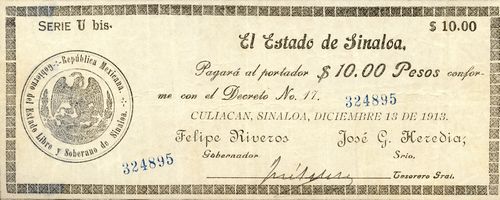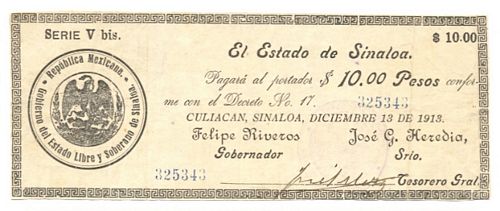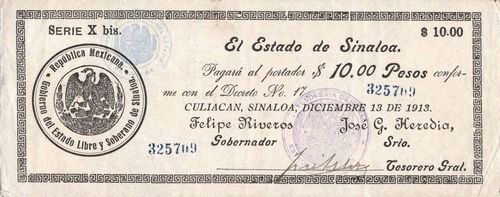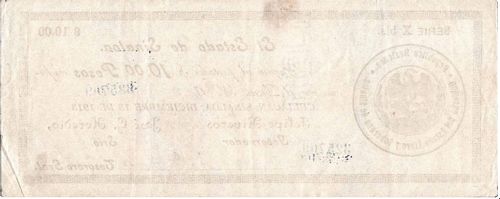The Meza affair
On 20 November 1914 Riveros declared himself a Villista and left Culiacán to establish his government in San Blas. On 8 March 1915 state treasurer Meza was arrested for embezzlement, as since 25 November he had supposedly put into circulation a large quantity of notes without authorization (indebidamente).
On 25 March the new provisional governor, Manuel Rodríguez Gutiérrez, decreed that these notes should be identified and revalidated by the Treasury General within two months so as not to prejudice their holders. Without this they would not be acceptable. According to the judicial proceedings the notes in question were:
| Number | Denom. | Series | Total value |
| 10,000 | 25c | Y bis | 2,500.00 |
| 1,000 | 50c | Y bis | 500.00 |
| 10,000 | 50c | Y bis | 5,000.00 |
| 1,000 | $1 | B bis | 1,000.00 |
| 2,500 | $1 | B bis | 2,500.00 |
| 2,500 | $1 | B bis | 2,500.00 |
| 2,500 | $1 | C bis | 2,500.00 |
| 2,500 | $1 | H bis | 2,500.00 |
| 3,000 | $1 | [ ] | 3,000.00 |
| 2,500 | $5 | W | 12,500.00 |
| 1,000 | $5 | P bis | 5,000.00 |
| 1,000 | $5 | Q bis | 5,000.00 |
| 1,000 | $5 | R bis | 5,000.00 |
| 1,000 | $5 | S bis | 5,000.00 |
| 1,000 | $5 | V bis | 5,000.00 |
| 500 | $10 | H bis | 5,000.00 |
| 500 | $10 | T bis | 5,000.00 |
| 500 | $10 | U bis | 5,000.00 |
| 500 | $10 | V bis | 5,000.00 |
| 500 | $10 | Y bis | 5,000.00 |
| 84,500.00 |

authorised

unauthorised
The difference between the authorised and the Meza notes were:
| GENUINE | MEZA |
| Shield is small | Shield is larger |
| In the shield ‘República Mexicana” is separated from 'Gobierno del Estado Libre y Soberano de Sinaloa’ by two dots and two lines in the form of a cross | Separated by a thick point in the immediate vicinity of the impression (por un punto grueso a inmediaciones de la impresión) |
| The letters of the text are small | The letters of all the text are larger and clearer |
The governor added that no public office should accept any of the dubious note with the seal of the Tesorería General, which did not have Meza’s authentic signature or were presented for revalidation within two monthsPeriódico Oficial, Tomo VI, Núm. 25, 26 March 1915.
On 15 June, in response to a request from the Tesorero General interino, Antonio Aguilar, this period was extended for another two months, until 25 JulyPeriódico Oficial, Tomo VI, Núm. 76, 19 August 1915 and on 21 August the period for revalidation was extended for another two months, until 21 October 1915Periódico Oficial, Tomo VI, Núm. 80, 28 August 1915.


The unauthorised note above ($10 X bis 325709) has two circular stamps: 'TESORERIA DEL ESTADO - DE SINALOA' and a larger 'TESORERIA GENERAL - ESTADO DE SINALOA'.
On 6 August the Treasury General produced a list of the notes that it had revalidatedPeriódico Oficial, Tomo VI, Núm. 71, 7 August 1915:
| Number | Series | Value | Total | |
| 4,017 | 25c | Y bis | $1,004.25 | $1,004.25 |
| 3,086 | 50c | Y bis | $1,543.00 | $1,543.00 |
| 2,130 | $1 | B bis | $2,130.00 | $9,036.00 |
| 1,688 | C bis | $1,688.00 | ||
| 1,332 | D bis | $1,332.00 | ||
| 1,538 | E bis | $1,538.00 | ||
| 1,144 | H bis | $1,144.00 | ||
| 1,204 | K bis | $1,204.00 | ||
| 577 | $5 | P bis | $2,885.00 | $17,340.00 |
| 585 | Q bis | $2,925.00 | ||
| 620 | R bis | $3,100.00 | ||
| 400 | S bis | $2,000.00 | ||
| 307 | V bis | $1,535.00 | ||
| 979 | W bis | $4,895.00 | ||
| 1 | $10 | H bis | $10.00 | $14,290.00 |
| 330 | N bis | $3,300.00 | ||
| 67 | T bis | $670.00 | ||
| 320 | U bis | $3,200.00 | ||
| 450 | X bis | $4,580.00 | ||
| 253 | Y bis | $2,530.00 | ||
| $43,213.25 |
Thus, to this date the percentages revalidated were, though the Tesorería continued to revalidate notes:
| Number | Denom. | Series | Total value | Revalidated to date | |
| 10,000 | 25c | Y bis | $ 2,500.00 | $ 1,004.25 | 40% |
| 11,000 | 50c | Y bis | 5,500.00 | 1,543.00 | 28% |
| 6,000 | $1 | B bis | 6,000.00 | 2,130.00 | 36% |
| 2,500 | $1 | C bis | 2,500.00 | 1,688.00 | 68% |
| $1 | D bis | 1,332.00 | |||
| $1 | E bis | 1,538.00 | |||
| 2,500 | $1 | H bis | 2,500.00 | 1,144.00 | 46% |
| $1 | K bis | 1,204.00 | |||
| 3,000 | $1 | [ ] | 3,000.00 | 0% | |
| 1,000 | $5 | P bis | 5,000.00 | 2,885.00 | 58% |
| 1,000 | $5 | Q bis | 5,000.00 | 2,925.00 | 59% |
| 1,000 | $5 | R bis | 5,000.00 | 3,100.00 | 62% |
| 1,000 | $5 | S bis | 5,000.00 | 2,000.00 | 40% |
| 1,000 | $5 | V bis | 5,000.00 | 1,535.00 | 31% |
| 2,500 | $5 | W [bis] | 12,500.00 | 4,895.00 | 39% |
| 500 | $10 | H bis | 5,000.00 | 10.00 | 0% |
| $10 | N bis | 3,300.00 | |||
| 500 | $10 | T bis | 5,000.00 | 670.00 | 13% |
| 500 | $10 | U bis | 5,000.00 | 3,200.00 | 64% |
| X bis | 4,580.00 | ||||
| 500 | $10 | V bis | 5,000.00 | 0% | |
| 500 | $10 | Y bis | 5,000.00 | 2,530.00 | 51% |
| $84,500.00 | $43,213.25 | 51% |
On 16 August, Meza, then imprisoned in the city jail, wrote an open letter to La Voz de Sinaloa, making serious accusations against the governor and other public functionaries. This was answered by another open letter from the governor, published in the Periódico OficialPeriódico Oficial, Tomo VI, Núm. 78, 21 August 1915. Manuel Rodríguez Gutiérrez acknowledged that Meza was entitled to his day in court, but said that he was accused of two crimes, firstly of having embezzled funds from the Treasury, and secondly of having circulated a large quantity of notes of those which he was authorized to issue, for his own benefit. The first he had tried to cover up with a supposed vale from a Señor Heaton for $10,000. The second consisted in the fact that he had issued notes without making the corresponding entries in the Treasury’s books. In time the evidence would be presented in court and Meza would either be vindicated or receive his just punishmentPeriódico Oficial, Tomo VI, Núm. 78, 21 August 1915.
Presumably this refers to some dispute between the former Convencionista regime and the new rulers but how were the unauthorized notes distinguished and was the validation just a Tesorería General stamp? If Meza had merely issued notes without recording them why did they need to be of a different printing?
